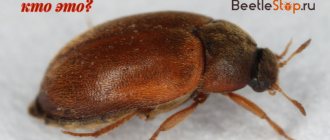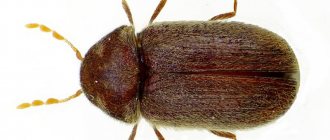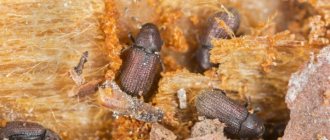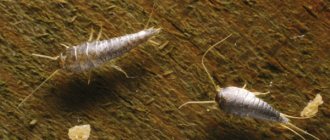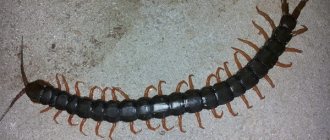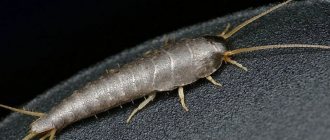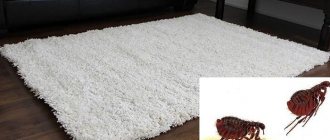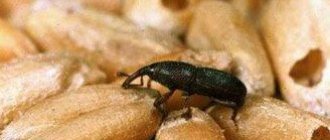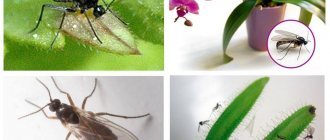In the spring, many Russian residents are faced with the appearance of small bugs on the windowsill. They come in different types and fly into the light from the window. If there are a lot of bugs, most likely there is a nest with larvae in the house. The resource “VredStop.ru” has collected information about the most common pests that fit the description “brown and black little bugs.”
Little brown bugs in the apartment - who are they?
Most brown bugs that appear in the house are small in size. Therefore, it is difficult for non-specialists to understand which insect has invaded the home. The most common types of skin beetles and grinders are found.
Carpet beetles
Their family consists of many varieties. More often they are distinguished by food preferences. Small brown bugs living on the windowsill feed on wood. The flower beetle lives in pots with plants, the carpet beetle prefers textiles, fur products have to be saved from the fur beetle, and the ham beetle loves food.
Carpet beetle
It is quite difficult to see the insect, since its size (on average 3–4 mm) and dark brown color allow it to remain invisible against the background of the interior. They are usually discovered by accident. Indirect signs will allow you to understand that the small bug flying in the apartment is a skin beetle:
- Peculiar paths have appeared on things or products, gnawed by the pest.
- Red dots appear on the body from skin beetle bites. The main difference from wounds caused by other insects is that this insect also bites under clothing that fits tightly to the body. Moreover, he does this irregularly.
Rarely found in rooms with high humidity, as they prefer a dry climate.
Grinder beetles
The small brown insect may also be a borer. Most often, furniture, house or bread beetles infest apartments. All of them are less than one centimeter in height. Only the larvae cause harm; the adults die immediately after laying eggs.
- The furniture maker does not disdain any type of wood. Moreover, he is attracted to any cellulose product. The first sign of such a pest is the unusual sound of a “mechanical clock ticking”, clearly audible in silence. These are the males, rhythmically knocking their heads against the walls of the passages, calling on the females to mate. Yellowish dust around chairs, cabinets, and under the bed should also alert you. It spills out of small holes in furniture made by pests.
- The house grinder prefers to settle on the outside of the walls. It is dangerous for wooden buildings. In high-rise buildings it is found on balconies and loggias, feeding on decoration made from natural materials.
- Small brown bugs that live in the kitchen or where grain products are stored in the house may be bread borers . Then cereals, flour and pasta are at risk.
Prevention
Everyone knows that it is much easier to periodically carry out preventive measures than to get rid of already established parasites. At least several times a year, you should do a general cleaning, move away large furniture, wash behind and under it, wipe off dust from objects and vacuum thoroughly. Books also need periodic revision.
Any cracks or chips found on furniture must be treated and sealed. Cereals should be stored in glass or plastic tightly closed jars or well-tied plastic bags. If food is stale, it is better to get rid of it immediately so that brown bugs do not appear there later. The shelves on which food is stored also need to be periodically wiped and dried.
If you find small brown insects on the windowsill or anywhere else in the apartment, you should not panic. Most likely, these are carpet beetles or borers. They do not pose a serious danger to humans, but you should get rid of them as soon as possible so that they do not cause damage to furniture, books, clothing or food.
Routes of penetration
When small bugs appear in the house, everyone wonders where they came from.
Carpet beetles can enter an apartment from an infested room on clothes, shoes or in a person’s bag. Sometimes they come from neighbors through small cracks near pipelines, ventilation holes, open windows or entrance doors. If you see a bug on the windows, you should not ignore it. We need to figure out where she came from and whether there are any of her brothers in the house.
The food-eating beetle and bread grinder beetle can be brought from the store along with the cereal. This happens if the rules for storing and processing products are violated in warehouses or granaries.
Bread grinder
Infestation of a wooden house by insects that spoil wood often occurs at the stage of procurement of building material. They can also be brought in old furniture or brought in with boards during renovation. If such bugs begin to crawl around the apartment, you need to check not only wooden products, but also the floor, baseboards, window sills, and frames. If found, immediately take measures to destroy them.
Mucoeds
They are polyphagous beetles, that is, their menu is very diverse. Three types can be found in apartments.
Surinamese
A beetle 3-3.5 mm long with a red-brown back. The pest is flat, very elongated in length, with a thin body. The pronotum has characteristic longitudinal “ribs”.
Interesting!
The first copies were delivered from Suriname, hence the name. Distributed everywhere.
Prefers bakeries as a bottomless source of nutrition. But often, along with flour and cereals, it gets into apartments, where it infects other supplies. The vital activity of bugs leads to an increase in humidity in products, which is why mold forms in cereals.
Maximum lifespan 3 years. Usual 6-10 months. The life cycle is 27-51 days at a temperature of 29-35°C.
During her life, the female lays 43-285 eggs. At an ideal temperature of 27-29°C, the larvae hatch after 3-5 days. The larva grows up to 3 mm, has a yellow-white color and a brown head.
On a note!
Theoretically, Surinamese mucoeds fly, they have wings. In practice they just crawl.
Red mukoed
The light brown beetle is approximately 2 times smaller than its Surinamese “brother”. In the apartment, the food supply, habitats and life cycle are similar to those of the Suriname mucoedeater. A distinctive feature of the red mucous eater is inactivity.
Mucoeds
Merchant beetle
A flat small beetle, 2.5 cm long. Almost completely identical to the Surinamese beetle in morphology and lifestyle, differing in eye size and head shape. The bugs crawl actively, moving to new habitats.
How to get rid of bugs in an apartment?
When bugs have just appeared at home and have not yet had time to multiply, it is better to use folk remedies. This is a safer method of getting rid of pests. In case of severe contamination of the premises, it is necessary to resort to drastic measures in the form of pesticides.
Chemicals
When purchasing medications to get rid of small bugs in an apartment, they most often buy universal products, since it is believed that they will help against all insects. For brown pests, it is better to select highly targeted insecticides.
They help well against skin beetles:
- Aerosols “Molemore”, “Raid”, “Raptor”. They spray cabinets, baseboards and other places where insects accumulate. After some time, the treatment must be repeated, as a new generation of pests may appear.
- Powder products can destroy not only adults, but also larvae. They are diluted and treated with a spray bottle, rubbed into carpets and upholstery on furniture, and sprinkled on the floor in places where bugs appear.
- Nimol and Dezmol tablets
- Microcapsule concentrates have a contact effect. Causing paralysis, they destroy insects.
Grinders spend almost their entire lives inside the tree, emerging only to mate. Therefore, most drugs are used to apply a toxic protective layer to the surface of the product. To achieve results, you must strictly follow the instructions.
Fumigating a room with products containing phosphines is more effective, since in this case the insecticides will penetrate into the most inaccessible places. Furniture can also be sprayed with Dichlorvos, then wrapped in plastic wrap for a day.
Dichlorvos
To ensure that bugs are removed from your apartment, you should contact specialized services that have both professional preparations and the necessary equipment.
Folk remedies
People have long noticed that you can get rid of small bugs by freezing them out, since they do not tolerate negative temperatures. This cannot be done in an apartment, but in a private house or country house it is possible. It is enough for the temperature to last below -10 °C for several days.
- Boric acid powder, poured in the places where they appear, helps well against skin beetles. They also do not like strong odors, so you can spray the area where the pests live with a vinegar solution (1 tablespoon per liter of water). If brown bugs are found in the bed, you can expel them from there with the aromas of essential oils, moisten a cotton pad with them and wipe all surfaces, including the mattress.
- Grinder beetles are expelled with Vaseline oil, a mixture of turpentine and kerosene, or naphthalene and black tar. One of these compounds is used to treat the damaged areas, making sure that the solution gets into all the holes. After a few days, the procedure is repeated.
Disinsection procedure
In order for the treatment of a room from brown bugs to produce results and not harm household members, you must adhere to some rules:
- Identify places where insects accumulate. Carefully inspect all furniture. Look for bugs under baseboards, in window frames, flowers, carpets, leather and fur products.
- Check seeds, cereals, flour, dried fruits for the presence of bugs. Throw away all contaminated and suspicious products. Place the rest in the freezer for several hours.
- Empty kitchen cabinets by storing dishes and food in airtight containers.
- Remove all residents and pets from the apartment.
- When processing the premises, be sure to use protective equipment.
- Spraying with pesticides should be done with the windows closed in the direction from the far corner to the exit.
- Upon completion of the work, close the apartment and leave it for several hours.
- After through ventilation, carry out general cleaning using a soap-soda solution.
Harm
Now we’ll tell you what leather beetles can eat in our house, and why they are actually harmful. Depending on where these bugs are found, they can damage:
- fabrics;
- cardboard;
- wallpaper glue;
- book spines;
- Hercules flakes;
- meat
- fish;
- cereals;
- cheese;
- fur;
- skin.
In addition, skin beetles climb into feather and down pillows, and when crawling out, they bite people, which is very painful and dangerous for infections.
Advice! Never eat food damaged by skin beetles. This is dangerous for your health!
Risk factors
Skin beetles spread most in those rooms where there are so-called risk zones or where there are objects that are particularly attractive to insects. You need to monitor the appearance of bugs especially carefully if your home has:
- pets whose fur beetles love to eat;
- the same applies to stuffed animals;
- fur coats, sheepskin coats, leather jackets in your wardrobe are a very attractive place for leather beetles;
- The pride of your home - a large library - is also at risk.
Preventive measures
If the home is old, then it needs to be renovated a little. The main tasks in this case: filling gaps in the frame of the house, window frames, door frames, ceilings, walls.
It is important to block access to the housing area through ventilation ducts. A fine-mesh mesh is installed here. Mosquito nets are attached to the windows.
If items are sent for long-term storage, they must be placed in pre-treated cabinets. The fur coat is contained in a bag; before this, an insecticide is also sprayed over it. Before using these clothes, they are washed. In the kitchen, you need to regularly clean cabinets and check supplies. It is better to process all bulk products that are brought from the store using the freezing method.
Related posts:
Treating the premises after getting rid of insects
If the fight against arthropods is successful, you need to take some steps to avoid encountering them again in the near future:
- we do the cleaning . Places where insects have accumulated must be washed using detergents;
Wash windows using detergents - this will get rid of traces of insects
- sorting out the products . Storage areas for vegetables and fruits also need to be washed. In this case, it is necessary to sort out the products. If rotten vegetables or fruits are found, they must be disposed of;
- We are taking preventive measures . We install the net and make sure that there are no food residues left in the room.
Classification of domestic skin beetles
There are several types of carpet beetles. Some settle in living rooms or bedrooms, while others move into the kitchen and spoil food supplies. Only the larvae pose a danger to people - they begin to actively feed immediately after birth. But adult beetles eat only plant sap or nothing at all.
- Carpet moths are dark brown individuals that feed on house dust;
- Ham - in the European part of the world this is the most popular type of beetle. Its main distinguishing feature is its body shape - long, with yellow spots on top; Smirnov's carpet beetles - these small bugs, more often than other species, settle in apartments; House or museum bugs - hide in flowerpots; Fur bugs - the most harmful type, eats homemade products, It is distinguished by its black spotted coloring.
The beetles of the fur coat beetle are brighter in color than the beetles of the carpet beetle.
To make it easier for you to recognize these bugs, we provide you with photos and names for them.
Larvae also have their own classification:
- Anthrenus - found on clothing and other fabric surfaces; Attagenus - found in bulk products, on carpets, at the bottom of drawers and bags, under parquet boards.
Interesting! Skin beetle larvae will not tolerate bright lighting - they live in dark places.
How to prevent insects from appearing on windows
Before we talk about fighting insects, let's consider the reasons why they appear and ways to prevent their occurrence.
So, in homes, midges most often appear on windows, or rather, Drosophila flies. These are absolutely harmless insects, however, they are annoying and unpleasant. Moreover, they reproduce very quickly.
Meet the Drosophila fly, or just a midge
As a rule, fruit flies appear on windows for the following reasons:
- leftover food. It is enough to leave a half-eaten apple, a slice of watermelon or a banana skin on the windowsill, and fruit flies will immediately appear on the window. Therefore, make sure that food is not left open indoors.
Leftover fruit is the favorite food of midges
Who are skin beetles?
Specialist coleopterologists classify this small insect as a member of the order Coleoptera. It has a brown sometimes black color. The insect is small oval in shape. The entire body is covered with short, stiff hairs.
Brown beetles are divided into four large classes, each of which contains from two to eight species. According to this classification, there are more than 600 species.
Types of bugs, what do they eat?
The following types are most common in apartments:
Any household items serve as a breeding ground for them: from organic compounds (leather goods, fabrics, books, furniture, carpets, waste products) to synthetics.
The diet includes: cardboard, felt, rubber, cable braid, asbestos structures. Capable of eating indoor plants and flowers. They can cope with almost all plant foods.
The grain beetle is capable of destroying nuts. Various types of grains and cereals, bran flour and products made from them. Ham specializes in meat and fish products.
